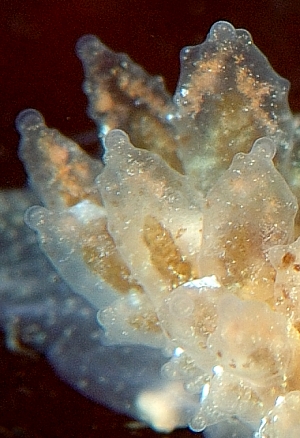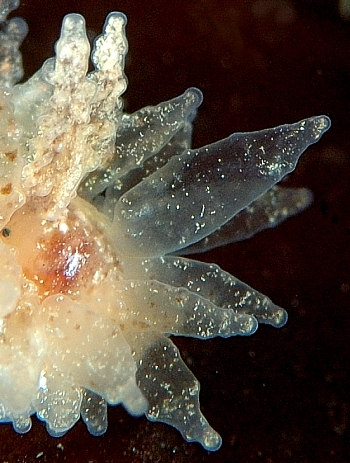Proctonotus mucroniferus? from Norway
May 8, 2007
From: Christian Skauge


Concerning message #19850:
Hi,
I found this very strange nudibranch at Vikaneset south of Krstiansund on the Norwegian west coast on saturday April 28th. I turned to Jussi Evertsen for help identifying it, and he came up with a probable/possible Proctonotus mucroniferus identification.
As this nudi seems extremely rare, I'd like to hear if anybody knows more. As far as I can tell, it has never been seen in Norway, and it is also not listed by MarBEF. According to Habitas in the UK it has only been seen once since 1937 in the UK, and is otherwise only known from the French Atlantic coast.
Locality: Vikaneset, Kristiansund, 6-7 metres, Norway, Atalntic, 28 April 2007, Rocky, Kelp forest. Length: Ca. 10 mm. Photographer: Christian Skauge, www.dykkefoto.no.
Any other species suggestions would also be greatly appreciated.
Unfortunately, I have just a few images (more or less the same angle) as the piece of kelp it was sitting on was taken by a wave and disappeared. I found it on a night dive at about 6-7 meters depth, rocky bottom with dense kelp forest and algae. Sizewise I'd say it was about 10 mm long. It's hard to tell, but as I remember it, it was pretty bare-backed and would go pretty well along with the description I got from Jussi.
Best regards,
Christian Skauge, Norway
www.dykkefoto.no
post@dykkefoto.no
Skauge, C., 2007 (May 8) Proctonotus mucroniferus? from Norway. [Message in] Sea Slug Forum. Australian Museum, Sydney. Available from http://www.seaslugforum.net/find/19877
Dear Chris,
This is an interesting find and I would agree with Jussi's identification. Proctonotus mucroniferus has seldom been recorded, and little is known of its anatomy, and even less about its biology. As far as I know its radular morphology is still unknown. Thompson & Brown (1984) summarise the available information. As your photo shows its has a number of rows of cerata around the edge of the body, including around the front of the head. Proctonotus differs from the quite similar looking Janolus in not having the wrinkled crest of 'caruncle' between the rhinophores. In the closeup of the head alongside there is no sign of a caruncle between the rhinophores, which in this species are wrinkled and nodulose. I have also included a closeup [middle photo] of the posterior cerata. In these we can see a brown duct running about halfway up each ceras. This duct is a branch of the digestive gland which is usually found in the cerata of zephyrinids. However Thompson & Brown state that ' the frontal cerata apparently lack the ... digestive gland tributaries..' and in your photo they also appear to be absent from the anterior cerata. [Unfortunately, in Thompson & Brown (Fig 24), the artist has apparently added these ducts in the anterior cerata by mistake].
One other confirmation of its identity is Thompson & Brown's description of the ceratal tips as "curiously truncated and button-like" which fits your animal well.
-
Alder, J. and Hancock, A. (1844) Description of a new genus of Nudibranchiate Mollusca, with some new species of Eolis. Annals and Magazine of Natural History 13: 161-166.
-
Thompson, T. E. and Brown, G. H. (1984) Biology of Opisthobranch Molluscs Vol 2. 229 pp. 41 Pls. Ray Society 156.
Best wishes,
Bill Rudman
